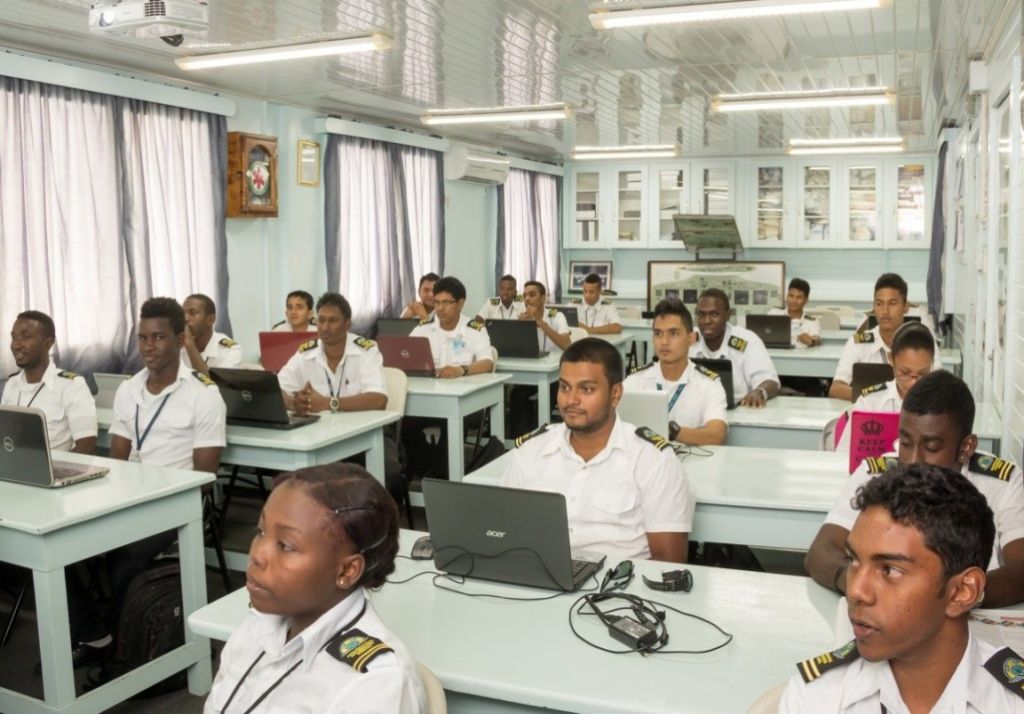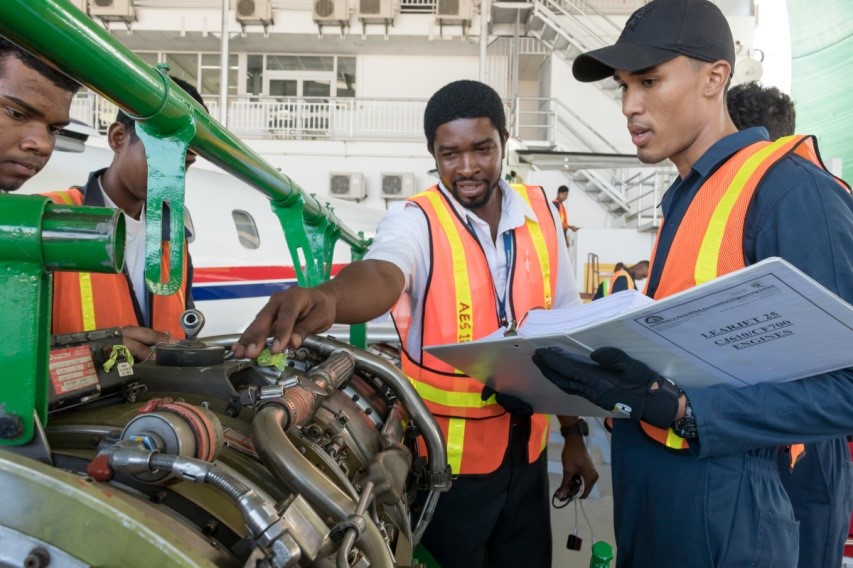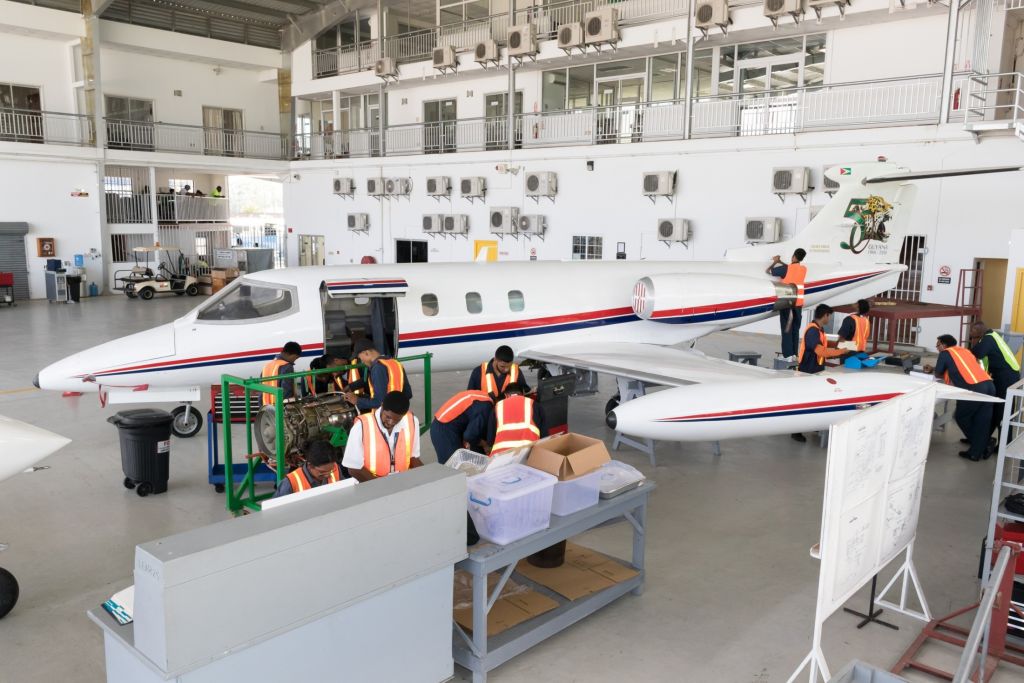Programme
There are two aspects to this training
Academic
Practical
Over the four years, the trainee receives classroom training, covering every aspect within their chosen specialty – mechanical or avionics. Examinations after each unit ensure that they have achieved a level of academic excellence equivalent to that of a Licenced Aircraft Maintenance Engineer.
Additionally, the trainee will be placed on a 48 months On-the Job-Training placement, usually rotated throughout Guyana’s aviation maintenance organizations. This ensures that the trainee gets the fullest possible exposure to the widest range of aircraft, with the highest available quality of professional supervision Guyana can offer. Their progress through this manual competence aspect of their training is monitored closely by the School.
In addition, the trainee is required to complete assignments, in their own time, set by the School, which link their classroom studies to the experience they gain in the hangar environment.
Graduation at the end of the Programme is dependent upon success at every stage, in both the academic and practical aspects. The School exercises a high level of quality control over this, and any student unable to achieve our very exacting and high standards of competence and knowledge are referred and recommended to repeat the year.
The Subjects… All the subjects are studied in accordance with the Guyana Aviation Requirements (GARs) and the ICAO Doc. 7192, AN/857 Part D-1, Second Edition – 2003, whichever is the most in-depth.
Course Structure
The program is full time and the course runs for approximately four-and-a-quarter years as it encompasses theoretical and practical training. Upon completion you’ll receive an Associate’s Degree, two Completion Certificates (theory and practical) and your AME License from the GCAA provided you pass their exam. In your school career here at Art Williams, you would need to complete all courses, all projects and obtain at least 2000 hours of On the Job training.
Induction Courses
- Occupational Safety and Health Practices
- First Aid – First Responder
- Transportation of Dangerous Goods
- Fire Fighting Techniques
- Airside Training
- Security Awareness
- HIV/AIDS Awareness
- Introduction to ISO Quality System
- Critical Thinking
- Chemistry
Year One Courses
- Mathematics
- Physics
- Human Performance
- Technical Drawing
- Maintenance Practices & Materials: Airframe/ Powerplant
- Fixed Wing Aerodynamics & Flight Control
- Rotary Wing Aerodynamics & Flight Control
Year Two Courses
- Electrical & Electronic Fundamentals
- Aircraft Systems & Structures – Fixed Wing
- Aircraft Systems & Structures – Rotary Wing
- Maintenance Practices & Materials: Avionics
- Digital Techniques
- Aircraft Electrical Systems
Year Three Courses
- Fuel Systems
- Piston Engines
- Civil Aviation Requirements, Laws & Regulations
- Propellers
- Gas Turbine Engines
Year Four Courses
- Aircraft Instrument Systems
- Aircraft Inertial Navigation System (INS)
- Automatic Flight Control Systems (AFCS) – Rotary Wing
- Automatic Flight Control Systems (AFCS) – Fixed Wing
- Aircraft Radio & Radio Navigation Systems
Course Layout
Courses are broken down into 3 parts
Part 1
Theoretical Training – Modules are taught in the classrooms and a Certificate of Achievement will be issued upon successful completion of each Module

Part 2
Skills Training – This involves 2000 hours of practical training at the Workshop Facility

Part 3
Practical Training on aircraft – consist of base maintenance, line maintenance and administrative procedures as regards aircraft maintenance. Students are exposed to maintenance at various attachment agencies

Ab-Initio Training
Objectives of the Ab-Initio Programme:
1. Develop skills in the workshops in the servicing, maintenance and repair of airframe structures and powerplants, including accessory and system components.
2. Gain practical on-the-job experience on aircraft, hangar practices and general aircraft maintenance engineering practices in order to meet requirements of the Guyana Civil Aviation Authority’s Aircraft Maintenance Engineer’s Licence.
3. Pass all the knowledge training (curriculum requirements) of the School and the Guyana Civil Aviation Authority in order to meet criteria of the various Licence Categories of the GCAA.
Ab-Initio, meaning “from the beginning” is a programme that is designed specifically for persons with proven academic ability and no previous aviation maintenance experience. The Ab-Initio Trainee Programme is designed specifically for those young persons, male or female, with proven academic ability.
This is a FULL TIME, four and a quarter year Programme which enables Trainees to be prepared for their Aircraft Maintenance Engineer’s License Without Type Rating – LWTR. The License Without Type Rating (LWTR) is a qualification issued by the Guyana Civil Aviation Authority (GCAA) – conversion to another country’s qualification may require further examination, especially on the Regulations subject. The term “Without Type” means that the qualification is not specific to any particular make or design of aircraft, but it covers all types of aircraft, its systems and components, large or small.
It is chiefly recognition by the Authority of the trainee’s level of experience, manual competence and academic achievement. The grueling written and oral assessments of all these are necessary for the GCAA to ensure that the candidate has attained a level of attitude and responsibility to be in charge of the airworthiness standards of passenger-carrying aircraft. The examination is set and marked by the GCAA’s office in Guyana, and the “License” is then issued.
After gaining the LWTR, the trainee then needs to study further to accumulate “Type Ratings” that is, they become specialists in types of aircraft – once you choose aircraft maintenance as your career, the sky’s the limit; there is always more to learn. The trainee is exposed to theoretical and practical training over the four and a quarter year period in order to ensure his/her readiness for the Aircraft Maintenance Engineer’s License examinations.
Trainees are trained in Basic Workshop Skills. Students gain practical experience by exposure to Aircraft Maintenance at various hangar facilities. Practical Attachment is monitored by Maintenance Supervisors. Work carried out is recorded in a logbook.


The first Ab-Initio Class commenced in 1997. Seven trainees attended the programme. One of these students is the First Female Ab-Initio Trainees in Guyana to be granted an Aircraft Maintenance Engineer’s License. Ms. Khareshma Bhagwandeen. License # 153 Airframe Training
The school offers a variety of external and modular training programs:
External Training
- Airside Training
- AVOC Training
- Dangerous Goods Training
- First Responder Training
Modular Training
- Aeroplanes II
- Beechcraft 1900D
- Instructional Techniques
- Technical Records
- Flight Operations Officer Training
Our BSc in Aircraft Maintenance Engineering is designed to equip students with the advanced knowledge and skills required to excel in the dynamic field of aviation maintenance. Building on our legacy of excellence, this degree prepares graduates for leadership and innovative roles in the industry.
Criteria for Admission
- Completion Certificate of the Ab-Initio Programme (Associate Degree in Aircraft Maintenance Engineering) from Art Williams & Harry Wendt Aeronautical Engineering School.
- Holders of an Aircraft Maintenance Engineer’s License or former graduates are pre-qualified at the Associate Degree level would need to complete the Grade 2 level Refresher Course which is for approx. 6 months. duration before they can complete the five Advanced Training Courses in Maintenance at 3 credits each to accomplish the BSc in Aviation Maintenance Engineering.
Registration requirements are as follows:
- Proof of Ab-Initio Programme completion/Proof of Aircraft Maintenance Engineer’s Licence.
- One passport sized Photograph
- Copy of National ID or Passport
- Completion of Enrolment Form
This BSc in Aircraft Maintenance Engineering aligns and consists of the following components:
- 122 credits for the satisfactory completion of all courses required for certification through Art Williams and Harry Wendt Aeronautical Engineering School’s Ab-Initio Programme or Modular Training for Aircraft Maintenance Engineer Licence holders to acquire the Completion Certificate of the Ab-Initio Programme.
- 122 credits will also be assigned to Aircraft Maintenance Engineer Licence Holders without the Associate Degree. However, they shall conduct approximately three months of Grade 2 Refresher training at the cost of G$100,000 prior to start of the Degree courses. An Attendance Certificate will be issued for this refresher training.
Courses in Bachelor of Science in Aircraft Maintenance Engineering
- Business English (ENG101)
- Management and Leadership in Aviation (MGL102)
- ISO 9001 Quality Management Systems Fundamentals (QMS103)
- Business Psychology (BPY104)
- Capstone (CAP105)
Duration: 10 months

